Celebrations
Culture

A military parade on Red Square; a workers’ parade for May Day; Pioneers saluting a red flag – these are all iconic images of international socialism. They highlight to what extent regularly scheduled, repetitive and collective celebrations were an integral part of Communist spirit and behavior. Lenin said in “What Is to Be Done?” (1902): the act of joining is at the root of the Communist movement. But it requires sacrificing part of one’s personal life to serve the Cause. So these celebrations symbolized the reiterated will of all individuals and all classes, to participate in an ideal – Communism; an action - the revolution, even in its most established phase, and an organization - the Party and its various instances. There were other dates as well (the anniversary of the October Revolution, or of local revolutions in different countries, etc.), all celebrated with quasi-religious intensity. This allowed for a renewal of the “act of joining,” and provided something to replace the former holidays tied to the “old beliefs” (i.e. Christmas, Easter, etc.). The cult of the dead, particularly of martyrs, was highly developed (heroes of the revolution, of the anti-Fascist resistance movement, and of the edification of Socialism) in the Soviet Union: newlyweds laid bouquets at the foot of monuments to the Great Patriotic War (WWII). This explains the multiplication of statues of Socialist heroes, the most important among them (Lenin, etc.) often being the work of Soviet artists – primus inter pares. But Celebrations for the masses were also intended for foreign eyes: they flaunted the people’s unity with their leaders, Socialist society’s organizational and structural prowess, and the omnipresence of the State. In a word, the idea was to impress the non-Communist world. “Joining” was encouraged from a very young age – in youth organizations (Komsomol, Communist Youth, Pioneers, etc.). In the early days of Communism, it was practically automatic (except in rare cases of “deviancy” or “resistance” on the part of either parents or children), but it became more selective as time went on (rates of Party membership varied widely depending on the country: while fairly common in East Germany (GDR) it was much more selective in Poland). It was also highly ritualized, with uniforms, salutes, frequently recited oaths of allegiance, elaborately staged initiation ceremonies, etc. Joining played a role in integrating groups of children, teenagers and even holiday-makers into society. Refusing to participate in these celebrations or to join these groups or organizations was synonymous with social exclusion. The political aspects ranged from barely perceptible (Hungarian summer camps on Lake Balaton in the 1980s were like any summer camps anywhere, aside perhaps, from the patriotic songs), to strongly focused on (para-military training was developed in East Germany at the same period). Joining also granted a certain number of privileges, from the symbolic (like becoming the heir to the struggle, being at the vanguard of humanity) to the more concrete: from extra vacation days for anyone who participated in May Day demonstrations and finding rare or rationed products in voting offices on election days in the USSR, to access to university and coveted careers and jobs. But by the late 1980s, many people were beginning to see these celebrations as hollow, meaningless wastes of time. Others continued to participate out of habit. The truly enthusiastic believers were becoming more and more rare.
Archive
An alternative Calendar for East Germans
The religious calendar, the infamous opium of the people in Marx’s words, is frowned upon. But something acceptable had to be found to replace religious holidays.
country: German Democratic Republic / year:
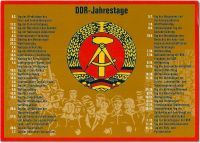
The religious calendar, the infamous opium of the people in Marx’s words, is frowned upon. But something acceptable had to be found to replace religious holidays. There are the big, obvious ones: March 8, women’s day; May Day, the worker’s holiday; November 7, the anniversary of the 1917 Revolution. This postcard shows that there is no shortage of other dates to celebrate (although few of them were legal holidays) in GDR: March 1, Army Day; June 5, Youth Brigade Day, November 8, Chemical Workers’ Day, etc. – each one with its own traditions, including medal ceremonies, inaugurations etc. The acme of the cult of personality: in the mid-80s, Nicolae and Helena Ceaucescu’s birthdays were declared national holidays in Rumania.
The Happiest Day of Their Lives
After signing their marriage license, Soviet newlyweds traditionally visit the monuments in their city to have their picture taken.
country: Soviet Union / year:
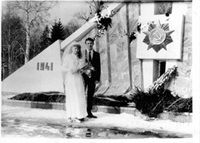
After signing their marriage license, Soviet newlyweds traditionally visit the monuments in their city to have their picture taken. In many newer cities, these include a huge central monument honoring soldiers who died in the Great Patriotic War, World War II’s official denomination in the Soviet Union. Sometimes the young couple even places a wreath in front of the eternal flame. The idea is to maintain Soviet patriotism and to keep the memory of the glorious Red Army’s spirit of sacrifice alive.
End of Winter Celebration
Despite the many official Socialist ceremonies that punctuated daily life, some traditional pagan or folk holidays survive, although the authorities cast a suspicious eye on them.
country: Soviet Union / year:
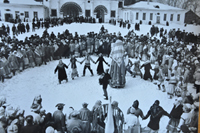
Despite the many official Socialist ceremonies that punctuated daily life, some traditional pagan or folk holidays survive, although the authorities cast a suspicious eye on them. Maslenitsa, for example, a sort of Russian mardi gras, also known as butter or pancake week, was tolerated by the 60s as the "End of Winter Celebration" in order to avoid using the old name, which came from traditional mythology. Nevertheless, people still eat blinis (symbolizing the sun’s return), dance, sing and go for sleigh rides. And huge bonfires are built to burn effigies of winter’s cold. Perestroika lifted the taboo on the old name, “Maslenitsa,” which is in use once again.
Orthodoxy, despite everything
Blessing of the cakes in church on Holy Saturday, after the Pascal service, before eating them at home. Despite – or perhaps because of – decades of persecution, orthodoxy has not disappeared from Russia.
country: Soviet Union / year:
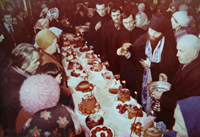
Blessing of the cakes in church on Holy Saturday, after the Pascal service, before eating them at home. Despite – or perhaps because of – decades of persecution, orthodoxy has not disappeared from Russia. Many Coptic popes and believers were persecuted, others manipulated by the KGB, and huge numbers of churches were closed, destroyed or used for storage. The outcome is that only a few people – in the countryside for the most part – still follow the old rituals: when they do, they run the risk of being denounced at work, excluded from the Komsomol etc. But almost everyone still enjoys a traditional Easter dinner, with eggs dyed red (using onion-skin dye) to symbolize... Christ’s blood. And on the day before Easter – which no longer officially exists, even the most Soviet of bakeries sells “spring cakes” whose shape and taste are indistinguishable from traditional Easter cakes. Since the opening of Perestroika, followed by the collapse of the Communism, Eastern Orthodoxy has been experiencing a tremendous revival.
I’m a Young Pioneer for the Soviet Union!
Admission into the Pioneers, with their music and their red scarves, was placed under the patronage of Lenin himself
country: Soviet Union / year:
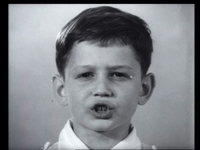
Admission into the Pioneers, with their music and their red scarves, was placed under the patronage of Lenin himself. The pledge enjoined children from age 9 to love the USSR and defend the CPSU. Activities ranged from scouting to picking up recyclable litter. It is inconceivable – synonymous with social and political death – for the children of a normal Soviet family not to join the Pioneers.
Working Class Heroes
For over 40 years, once a year on May 1, happy, colorful crowds would, according to the official rhetoric, come out to demonstrate their determination to marcher towards a victorious, radiant future
country: Czechoslovakia / year:
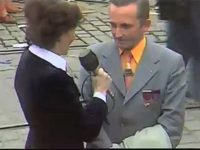
For over 40 years, once a year on May 1, happy, colorful crowds would, according to the official rhetoric, come out to demonstrate their determination to marcher towards a victorious, radiant future, towards Communism. As can be seen clearly in this 1978 report for the Czechoslovak state television, this holiday celebrated work, and workers were the heroes of the day. The population, organized into workplace-based delegations within the parade, was building a future Communist society through their work. The parade was a march for the masses, both literally and figuratively. The whole country, and all countries, marched together, at the same time (the parades in other European capitals always waited for the one on Red Square to give the signal to start), and in the same direction, towards the same ultimate goal. The parade was a representation of the entire history of the workers’ movement, from the first steps under Marx and Engels to the present day, via figures like K. Gottwald, the "first working-class president.” The slogans let people know the high points of the year, which leaders were in good graces just then, and the year’s production levels – in other words, how far society had come, even if it still had a long way to go to achieve Communism... Most workers’ collectives’ "spontaneous" vows to outdo their goals for the next five-year plan were sworn at May 1 ceremonies. And lastly, May 1 was a chance to flaunt role models and a put a representation of an ideal society (people’s militias, athletic champions, workers’ brigades) on display, for both the domestic audience and foreign spectators.
An anniversary in denial
7 October 1989. East Germany has been shaken by a wave of escapes and unprecedented demonstrations, but SED Party leaders are in denial.
country: German Democratic Republic / year:
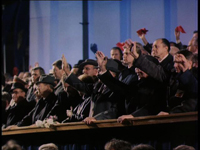
7 October 1989. East Germany has been shaken by a wave of escapes and unprecedented demonstrations, but SED Party leaders are in denial. A torch-lit parade on October 6 and a military one on the 7th: celebrations for the 40th anniversary of East Germany are organized as though everything were perfectly normal. Except that the Party’s resources were depleted. With the crowds shouting “Gorby, help us!” at the General Secretary of the CPSU in front of western news cameras, the celebration is a fiasco.
Parades: seeing and being seen
Rituals like this massive military parade on Red Square in honor of the October Revolution
country: Soviet Union / year:
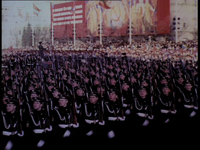
Rituals like this massive military parade on Red Square in honor of the October Revolution serve a dual purpose. First off: they reassure leaders that their power is in place. The parade is not intended as a public ceremony, but is actually for the benefit of the Politburo, which watches it from Lenin’s mausoleum. Secondly: to show foreigners (both friend and foe) that unity between the Party and the population is still thriving, and that it will be defended at all costs. The parades are also occasions for unveiling new military technology, as well as introducing new members of the inner circles of power.